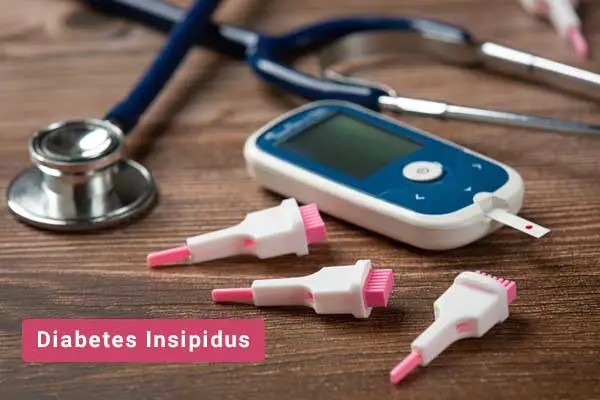Get The Answers To Your Questions About Diabetes Insipidus

Diabetes insipidus(DI) is a condition where urine production is excessive and causes water intoxication. DI is caused by a lack of vasopressin, a hormone produced by the pituitary gland. DI occurs in both children and adults and may be inherited or acquired. In some cases, DI results from damage to the hypothalamus, pituitary gland, or kidneys. In severe cases, DI can lead to dehydration, kidney failure, coma, and death.
People who have DI may produce copious amounts of dilute urine, even though they may not drink enough water. In rare cases, people with DI may experience severe thirst. The cause of DI is unknown. However, researchers believe that it may occur due to defects in the hypothalamus gland located in the brain. A hormone calledvasopressincauses the pituitary gland to release antidiuretic hormone (ADH). ADH then stimulates the kidneys to excrete excess water. If a defect occurs in the hypothalamus gland, it can prevent the proper functioning of the pituitary gland, preventing the body from producing ADH.
People with diabetes insipidus usually do not need treatment. Treatment may involve fluid restriction and/or medication. Fluid restriction involves drinking less than normal amounts of fluids. Medication may help reduce symptoms.
According to theNational Kidney Foundation, approximately 1 in every 10,000 people is affected by DI. In the United States alone, there are about 100,000 people with DI. People with DI tend to be young adults or children under age 5. There is no gender preference, although men seem to develop the condition slightly earlier than women. People with DI are often obese.
What are the different types of Diabetes Insipidus?

Central Diabetes Insipidus (CDI):The cause of CDI is unknown; however, it is believed to be due to an inability to produce vasopressin, a hormone produced in the hypothalamus. In humans, vasopressin causes water reabsorption in the kidney tubules and urine production. The lack of vasopressin results in decreased urine production, leading to a condition called central diabetes insipidus.
Symptoms of CDI may include thirst, polydipsia, polyuria, fatigue, weakness, weight loss, nausea, vomiting, headaches, vision changes, mental confusion, seizures, coma, and death.
Treatment of CDI includes fluid restriction, administration of desmopressin (DDAVP), and/or surgery. Fluid restriction involves limiting the number of fluids consumed daily. DDAVP is administered orally or intravenously. Surgery involves removing a portion of the pituitary gland.
Nephrogenic Diabetes Insipidus (NDI):The term nephrogenic diabetes insipidus describes a condition where the kidneys do not make enough urine due to the inability to concentrate urine. This results in the excretion of watery urine, leading to dehydration and low blood pressure.
There are two types of NDI:congenitalandacquired. Acquired NDI occurs when the kidney does not produce concentrated urine due to damage or disease. Congenital NDI is caused by mutations in the genes responsible for producing the vasopressin receptor. These receptors are located in the kidneys and allow them to respond to the hormone vasopressin. Vasopressin causes the production of aquaporins in the kidney tubules, which leads to the formation of concentrated urine. Mutations in these genes prevent the proper functioning of the vasopressin receptors, causing NDI.
Symptoms vary depending on what type of NDI a person has. People who have congenital NDI may experience symptoms similar to those seen in adults with diabetes insipidus. These symptoms include polyuria, high thirst, and fatigue. People with acquired NDI often suffer from urinary tract infections and kidney stones.
Treatment for both congenital and acquired NDI includes medication and surgery. Medication helps to increase the concentration of urine, while surgery replaces damaged parts of the kidneys and bladder. Both treatments require lifelong administration of medications.
Gestational diabetes insipidus:Gestational diabetes insipidus (GDI) is a condition where a pregnant woman’s blood glucose levels are higher than normal. Symptoms may include excessive urination, fatigue, and weight gain.
Causes of GDIs: There are two types of GDI:
Type 1 – This type occurs when insulin production is inadequate. Usually found in women who have had gestational diabetes before. It is often treated with a medication called Metformin.
Type 2 – This type occurs when the kidneys do not properly reabsorb water. Normally this happens after the pregnancy. Sometimes it can occur without any symptoms.
Treatment for GDIs includes diet changes and medications. Medications include Metformin and glyburide.
Dipsogenic diabetes insipidus:Dipsogenic Diabetes Insipidus (DDI) is a rare genetic disorder characterized by excessive thirst and frequent urination. Symptoms may appear at any age, although they tend to become evident after puberty. People who suffer from DDI have abnormally high levels of urine production. In some cases, people may even experience extreme dehydration.
Causes: The exact cause of DDD is unknown. However, researchers believe that mutations in the genes that regulate water balance may play a role. Individuals with DDD often have low blood pressure, which causes their kidneys to work harder than normal. As a result, they produce excess amounts of urine.
Treatment: Treatment for DDD is based on the severity of symptoms. If someone is experiencing mild symptoms, then he/she may be able to manage them using medication. Those suffering from moderate to severe symptoms may require hospitalization and treatment.
Diagnosis of Diabetes Insipidus

The diagnosis of DI involves testing blood levels of sodium, potassium, chloride, and osmolarity. A 24-hour urine test may also be performed to measure the amount of urine produced. If these tests show low levels of sodium and high levels of potassium and chloride, then the person may have DI. However, if the urine tests show normal levels of sodium and potassium, then the person does not have DI.
A doctor may order additional tests to determine whether the cause of DI is related to DM, kidney disease, or cancer. These tests include imaging studies, such as CT scans and MRI scans, and endocrinology tests, including blood tests to check hormone levels.
If the cause of DI cannot be determined after extensive testing, then treatment may involve replacing fluids lost due to excess urine production. Treatment options include medications to increase urinary flow, diuretics to reduce fluid retention, and surgery to remove parts of the brain that control urine production.
Causes of Diabetes Insipidus

The two most common causes of DI are tumors in the pituitary gland and damage to the hypothalamus. Other less common causes include the following:
- Genetic factors
- Brain tumors
- Infections
- Head injury
- Pituitary surgery
- Tumors of the hypothalamus
- Trauma
- Radiation therapy
- Hypothyroidism
- Hyperthyroidism
- Cushing’s disease
Symptoms of Diabetes Insipidus

- Polyuria (excessive urination):Polyuria occurs when the kidneys produce excessive amounts of urine. In people with diabetes, polyuria may occur due to increased blood glucose levels. These high blood sugar levels damage nerves, causing them to send incorrect signals to the kidney’s water-producing cells. The result? Too much urine.
- Polydipsia (excessive thirst):People who have diabetes tend to want to drink more than they should. There are several reasons for this behavior. One is that they feel thirsty even though their blood sugar level is only slightly elevated. Another is that their body does not get enough insulin to transport sugar out of their blood. When these two factors combine, the brain thinks the person is hungry. As a result, he or she feels compelled to drink.
- Nausea, Vomiting, Diarrhea:Diabetic patients often experience nausea and vomiting. This is caused by a lack of insulin, which prevents the proper functioning of certain nerve cells in the stomach. If left untreated, diarrhea could develop.
- Weakness:Because the body cannot properly use sugar, diabetics often become weak. Their muscles do not work as well as normal people’s, and they need extra help moving around. Diabetics also have trouble thinking clearly.
- Increased appetite:People with diabetes often eat more than normal. Because they know how dangerous high blood sugar levels can be, they try to avoid getting sick. Unfortunately, eating makes them feel better.
- Frequent urination:As mentioned above, diabetic patients often have difficulty controlling their urine output. Once again, this is because of damaged nerves and muscle cells. To combat this problem, diabetics often wear diapers.
- Dehydration: When the body loses too many fluids, dehydration occurs. People who have diabetes often have trouble keeping their bodies properly hydrated. Diabetics also lose salt and minerals, which further contribute to dehydration.
What are the various complications of Diabetes insipidus?
Complications of diabetes insipidus surgery: To treat DI, doctors will need to remove parts of the brain that control fluid production. Surgery is generally only done if the condition is severe, and the patient cannot tolerate any medications. There are many risks associated with surgery, including death.
Complications of diabetes insipidus treatment:Diabetes insipidus treatment requires patients to drink water frequently throughout the day. Drinking water helps dilute concentrated urine and prevent kidney stones. Patients often have to take medication to help them sleep at night.
Complications of diabetes insipidus:
- Kidney failure
- Blindness
- Damage to nerves or muscles
- Death
In conclusion,
Diet and nutrition can affect diabetes insipidus in several ways. First, if someone with diabetes eats too much sugar, their blood glucose level rises. If the blood glucose level becomes too high, the pituitary gland releases less vasopressin. In turn, the kidneys cannot excrete enough urine, resulting in DI. Secondly, certain foods can reduce the risk of diabetes.
There is a link between lower rates of diabetes and fruit, vegetables, whole grains, legumes, nuts, fish, and olive oil. Third, people who eat a lot of processed food tend to have higher rates of diabetes than those who eat mainly fresh foods. Finally, certain vitamins and minerals may play a role in preventing or treating diabetes. Vitamins A, B12, zinc, iron, and folic acid lower diabetes risk.







